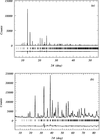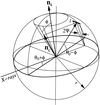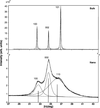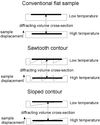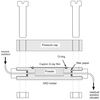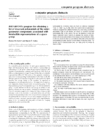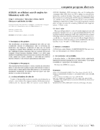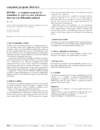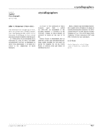issue contents
June 2003 issue

Cover illustration: Protein crystals in a 2 µl gelled microbatch drop dispensed automatically under oil. Courtesy of A. Moreno, E. Saridakis & N. E. Chayen [J. Appl. Cryst. (2002), 35, 140-142].
research papers
X-ray diffraction is a powerful non-destructive and phase-selective technique allowing the determination of both the mechanical and microstructural state of the diffracting phases in thin films and multilayers. Combining X-ray diffraction with in situ tensile testing, it is also possible to measure the intragranular elastic constants of each phase.
Structural and microstructural analyses associated with dielectric measurements bring to light original correlations between cationic disorder on Bi and Sr sites, microstrains and dielectric response in the ferroelectrics of the series Sr1−xBi2+xTa2O9.
A quantitative basis for the rocking-curve measurement of the preferred orientation in polycrystalline thin films is presented. A depth-dependent preferred orientation distribution in AlN thin films was revealed, and a very small degree of preferred orientation in Au thin films could also be measured.
The quantitative interpretation of 00l reflections enabled the determination of the number of intercalated water molecules, their positions and the stacking mode of the clay layers along the normal to the (a,b) plane, while the study of the hkl reflections with h and/or k ≠ 0 enabled the characterization of the structural evolution in the (a,b) plane of the hydrated kaolinite during dehydration. This study has shown that the association of the SAXS and XRD results allows one to describe the structure and the distribution of the number of layers per particle during dehydration.
A procedure for the systematic decomposition of groups of severely overlapping reflections in a powder pattern is described and experimentally tested.
Simultaneous measurements of optical retardation and orientation of the optical indicatrix resulting from the birefringence have been made on K2Mn2(SO4)3 (KMS) crystals. Birefringence images of the phase transition using the rotating-polarizer method clearly show the domain behaviour during temperature changes, especially during a phase transition.
Bulk- and nanocrystalline GaN have been studied by high-pressure energy-dispersive X-ray diffraction. Pressure-induced structural phase transitions from the wurtzite to the NaCl phase were observed in both materials.
The addition of a surface profile to a powder has been shown to ameliorate the issue of intensity fade with double Göbel mirrors where large sample displacements occur. Measurements have been taken both at high temperature and with precisely controlled displacements at room temperature to quantify the effect of a contoured surface.
Diffraction data collected on tetrafluoroterephthalonitrile with a Nonius KappaCCD diffractometer using different experimental parameters were analysed to find the optimal experimental conditions. These results were employed in the measurement of a data set for a charge density study.
computer programs
A computer program which calculates accurate inelastic scattering channelling maps is presented.
A modification of MolScript is presented that includes several new molecular graphic features and adds `persistence of vision' ray-tracing support.
laboratory notes
This note describes how the kinetics of powder reactions in percolating solution can be studied by X-ray diffraction using a wet-cell flow-through reaction chamber.
An air cooler is presented for regulation and simultaneous crystallization tests at different temperature gradients and crystallization rate intervals, with the purpose of obtaining crystals.
computer program abstracts
The program INVARIANTS, which aims to generate symmetry-allowed invariants associated with a given high-symmetry group H and the primary order parameter, along with invariants and coupling polynomials of the secondary order parameters, is described.
For a given group–subgroup pair of space groups, SYMMODES constructs the graph of maximal subgroups relating the two groups and calculates the corresponding symmetry modes.
The program LCELLS is described.
A computer program for the simulation of selected-area and precession electron diffraction patterns is presented.
crystallographers
Free 

book reviews
Free 



 journal menu
journal menu










